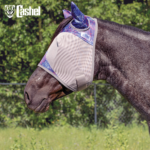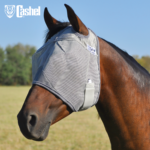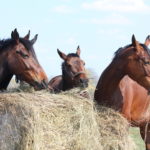Make a safe and systematic lesson plan when schooling a horse to stand steady.
Be sure to tie your horse high — at least wither height — and in an area free of clutter or debris.?

So you say Ol’ Red has hitching down pat. He’ll stand tied to anything, for any length of time, without any complaints at all. That is, as long as a pigeon doesn’t unexpectedly swoop down from the barn’s rafters. Or someone doesn’t happen to walk up to him with an open umbrella. Or he never decides that he has other, more pressing items on his personal agenda. But really, you insist, except for that time he broke his halter–which really doesn’t count since that stray deer had no business wandering through the barn looking for food–Red will stand when tied.
Still you also realize that you and Ol’ Red have been very lucky indeed. It’s quite possible that he could have flipped over backward during his struggle or run out onto the local expressway as he attempted to flee from the deer. In all honesty, you admit to yourself, there’s something seriously lacking in Red’s ability to stand tied. Perhaps some well-planned reschooling will convince him that when he’s tied there is no possible way he can escape–no matter what sort of equine-eating monster may appear in his vicinity.
Tie training is as essential a skill as you can ever teach your horse. After all, failing to perform a perfect piaffe or rollback will never jeopardize his well-being, but breaking through a hitch may put him, you and others at serious risk of injury or even death.
Although there are probably 101 ways to teach a horse to tie, the most effective programs address several factors. Safety to both horse and handler is paramount, and because the potential for injury is great when tie training is done imprecisely or haphazardly, consider hiring a professional if you’re at all uncomfortable with the prospect.
Since a horse does not know his own strength until he has tested it, your job when tie training is twofold: to make him believe that the use of force is not in his best interest, while at the same time preventing him from experiencing his full power, which can lead to injury. By carefully orchestrating the situation so that the horse causes his own discomfort whenever he pulls back, you’ll help to convince him that safety lies in the direction of the lead line.
As ominous as the training session may appear to an uninformed onlooker, the tie process, in the long run, can be pleasant and safe for the horse. The snubbing post may even become a reliable haven for an animal who has become confused by unpredictable reactions from people.
Excerpted from an article that first appearedin?EQUUS magazine.





